Past Members of the Group
|
Daphne Gavras Summer student (2024) Daphne used 57Fe Mössbauer spectroscopy to investigate the potential for critical metals recovery from crysotile tailings. |

|
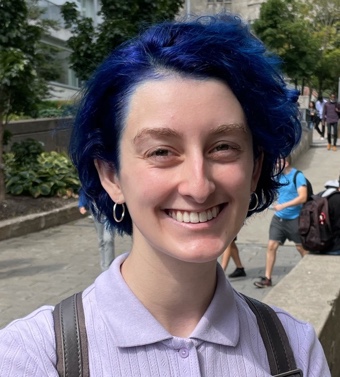
|
Emma Pappas Project and summer student (2021-2) Emma investigated the valence behaviour of europium in EuPd3S4. She followed up on an earlier study using trivalent substitutions (Y and La) by using divalent (Ca and Sr) replacements for the europium. |
|
Jeremy Lackman-Mincoff Project student (2021) Jeremy worked on a 151Eu Mössbauer spectroscopy study of flux-grown crystals of EuAl4 |

|
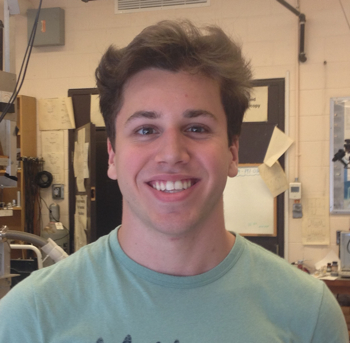
|
Ricky Zieghan CEGEP student (Vanier College) (2018) Ricky spent the summer working in the lab re-building our Mössbauer oven and designing a two-zone Arduino-based temperature controller to run it. |
|
Stefanie Siebeneichler Visiting Ph.D. student (Stockholm University) (2018) Stefanie visited for three months to learn about analysis of neutron powder diffraction data using FullProf. She started with some excessively complex Eu-based materials and then proceeded to carry out a complete analysis of a series of LaMn2Si2-xGex samples that exhibit a long-period conical ordering of the Mn moments. |

|
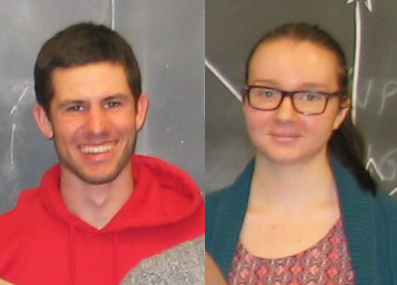
|
Quentin Stoyel and Larissa Veryha Majors Project Students (2016) Quentin and Larissa worked on HoFeO3: a multiferroic orthoferrite. They prepared many grams of material for inelastic neutron scattering measurements at OPAL in Australia, and for the neutron powder diffraction that they carried out using C2 at Chalk River, Ontario. |
|
Tim Miller Summer Student (2015) Tim set up an automated needle-valve controller on our rare-earth Mössbauer cryostat so that it now runs reliably 24/7 without operator intervention. He also interfaced all of out Lakeshore temperature controllers so that they could be run remotely. However, his most significant contribution was to design and build the TimBox: a $100 replacement for our MCS data acquisition systems that now runs all of our spectrometers. |
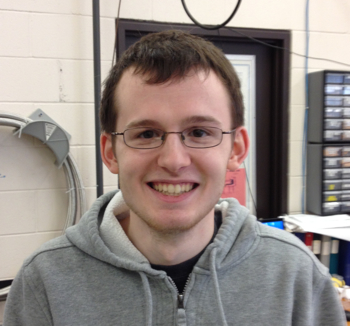
|
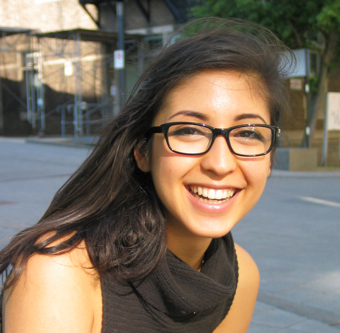
|
Rasa Rejali Summer Student (2014) Rasa worked on updating the Mössbauer experiment in the undergraduate labs and used 170Yb Mössbauer spectroscopy to study a variety of YbTZn and YbZnX compounds. |
|
Anaëlle Legros M.Sc. (2014) Anaëlle joined us as an intern student from the Université de Paris-Sud. She spent three months working on several new chalcogenide spin-ice candidates based on a spinel structure rather than the more common pyrochlores. She used 170Yb and 166Er Mössbauer spectroscopy in addition to neutron diffraction. |

|

|
Nadejda Mas M.Sc. (2014) Nadejda is completing her M.Sc. at École Normale Supérior de Cachan and visited us as part of an internship programme. She spent eight surprisingly cold weeks enjoying a Montreal winter while she used 57Fe Mössbauer spectroscopy to study synthetic jarosites and 155Gd Mössbauer spectroscopy to investigate magnetic ordering in Gd2Fe2Si2C. |
|
Dr. Gabriel Cabrera-Pasca PDF (2013) Gabriel visited the group from Sao Paolo, Brazil. He used our cold-source Fe Mössbauer spectrometer to study GdxCe1-xIn3, and the digital TDPAC spectrometer built by Tatiana to study TbIn3. He also travelled to the Canadian Neutron Beam Centre to use neutron scattering to study magnetic ordering in LaMn2Si2-xGex. |
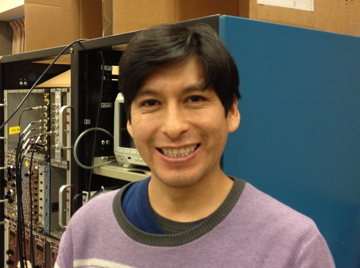
|

|
Nicholas Lee-Hone M.Sc. (2011−2013) Nicholas used 170Yb and 155Gd Mössbauer spectroscopy in combination with neutron powder diffraction to study magnetic ordering in a variety of rare-earth intermetallic compounds. |
|
William Rowan-Weetaluktuk M.Sc. (2009−2013) After a break from his studies, Nally returned to us and used 151Eu Mössbauer spectroscopy and neutron powder diffraction to investigate magnetic ordering In-flux grown single crystals of EuCu2Si2 and EuCu2Ge2. He also used 57Fe Mössbauer spectroscopy to study single crystals of KFe2Se2. |

|

|
Tatiana Webb M.Sc. (2009−2013) Tatiana designed and built a fully digital Time-differential Perturbed Angular Correlation (TDPAC) Spectrometer that uses 181Hf and 111In tracers to complement our extensive Mössbauer facilities. |
|
Katherine Quinn Summer Student (2011) Katherine used 57Fe Mössbauer spectroscopy to investigate the coexistence of magnetic order and superconductivity in Co-doped BaFe2As2. |

|

|
Chris Voyer M.Sc., Ph.D. (2003−2011) For his M.Sc., Chris used 170Yb Mössbauer spectroscopy to study the interplay of valence and magnetic order in the Yb5(SixGe1-x)4 giant magnetocaloric system. In his Ph.D. research, Chris used 119Sn and 155Gd Mössbauer spectroscopy in combination with neutron powder diffraction to investigate the magnetic ordering in the R3T4X4 (R=La−Lu; T=Cu,Ag; X=Si,Ge,Sn) family of intermetallic compounds. |
|
Madeleine Anthonisen Summer Student (2010) Madeleine used 57Fe Mössbauer spectroscopy to study nanocrystalline LiFePO4, a potential lithium-ion battery electrode material. |

|

|
Nicholas Lebel-Buchanan Summer Student (2009) Nicholas built a super-critical water cell in order to study corrosion of materials that may be used in Generation-IV nuclear reactors. |
|
Alex Beath Ph.D. (2000−2007) Alex used 57Fe Mössbauer spectroscopy and µSR to study magnetic ordering in site frustrated magnetic glasses. He also carried out numerical simulations using our 700-node Beowulf cluster to understand the details of our experimentally observed phase diagrams for both site and bond frustrated systems. He was awarded an NSERC-PDF scholarship and moved to UCSD. |

|
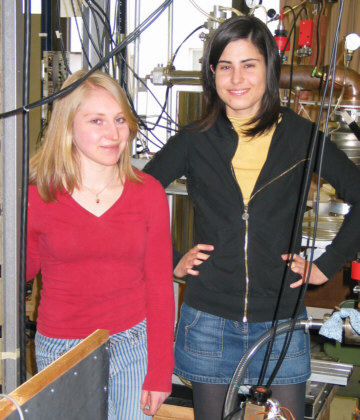
|
Elizabeth Ledwosinska and Eva Alonso Ortiz Majors Project Students (2007) Elizabeth and Eva used 57Fe Mössbauer spectroscopy to study phase stability and electron dynamics in LiFePO4, a lithium-ion battery electrode material. |
|
William Rowan-Weetaluktuk Majors Project Student (2007) Nally used 151Eu Mössbauer spectroscopy to investigate valence and magnetic ordering in indium-doped EuCu2Si2 alloys. |
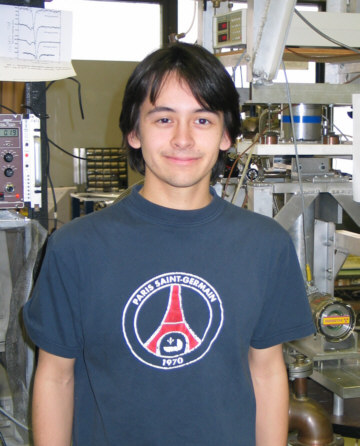
|
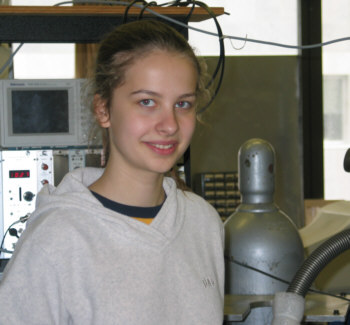
|
Olga Trichtchenko Summer Student (2006) Used 151Eu Mössbauer spectroscopy to study a variety of Eu3+ compounds. She also investigated erbium coordination in Er-doped Silicon by using 169Tm Mössbauer spectroscopy on neutron activated samples. |
|
Laura K. Perry M.Sc. (2004−6) Used 119Sn and 57Fe Mössbauer spectroscopy to study anisotropic contributions to the transferred hyperfine (Bhf) field in several RMn6Sn6 and RFe6Sn6 alloys. To do this, she followed changes in Bhf and the quadrupole splitting (Δ) through temperature and field driven reorientation transitions, using both powder and single crystal samples. |

|
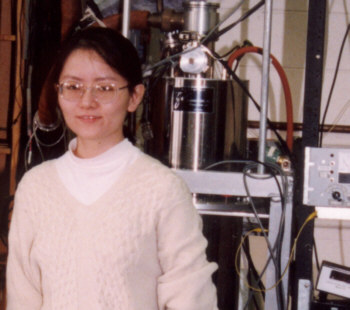
|
Li Cheng Ph.D. (1997−2004) Used a combination of low-temperature conversion electron Mössbauer spectroscopy (LT-CEMS) and polarised neutron reflectometery to study magnetic ordering in Fe/Cu, Fe/Ag and Fe/Pd multilayers. Her work demonstrated that palladium is polarised to a remarkable depth by contact with an ordered iron layer. |
|
Johan van Lierop Ph.D. (1996−2001) Johan developed selective excitation double Mössbauer spectroscopy (SEDM) to the point where it could be used to study dynamics in a wide variety of fine-particle and frustrated magnetic materials. He combined SEDM with µSR to study the magnetic fluctuations associated with transverse spin freezing in the bond-frustrated a-Fe100-xZrx system. Johan is now Assoc. Prof. at U. Manitoba. |

|

|
Dr. Alex Kuprin PDF (1996−1999) Alex greatly expanded our low-temperature conversion electron Mössbauer spectroscopy (LT-CEMS) facilities, adding two new detectors that could be operated down to 85K and 40K. He worked with two graduate students studying magnetic ordering in Fe/Cu, Fe/Ag and Fe/Pd multilayers. |
|
Shem Malus M.Sc. (1996−1999) Shem added a quadrupole mass spectrometer to our thermopiezic analyser system so that we could identify gases being evolved during thermal decomposition reactions. The system was used to study intercalated hard magnet alloys based on Nd2Fe17. He also conducted a 57Fe Mössbauer study of the pseudobrookite system: FeTi2O5−Fe2TiO5. |

|

|
Saleema Noor Mohammed Ph.D. Student (−2001) Saleema worked with me for about a year. Her project involved setting up a cold-source Mössbauer spectrometer to work with non-standard isotopes. She worked mainly with 170Yb, publishing papers on the YbCd5.7 binary quasi-crystalline system and magnetic ordering in Yb2Cu2O5 before moving to Chicoutimi for family reasons. |
|
Erol Girt Ph.D. (−1998) Erol made extensive use of both 57Fe Mössbauer spectroscopy and neutron diffraction (at the CNBC, Chalk River, ON) to investigate elemental site substitutions in two series of rare earth-based permanent magnet systems (R2Fe17 and R2Fe14B). He developed a model to account for the observed site selectivity that included both elemental affinities and site volume effects. Erol is now a Tier-II CRC chair of physics at Simon Fraser University in BC. |
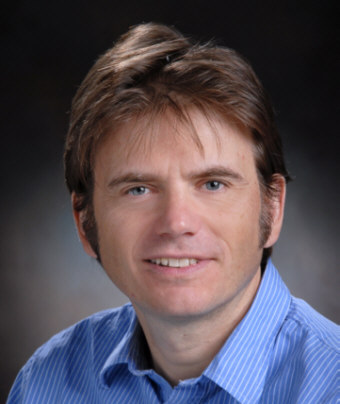
|

|
Dok Won Lee M.Sc. (1995−1997) Dok used low temperature conversion electon Mössbauer spectroscopy (LT-CEMS) to study magnetic ordering in Fe/Cu multilayers. |
|
Erwan Sourty M.Sc. (1995−1997) Erwan followed up on Louise Raymond's work on growing magnetic iron oxide particles in cellulosic membranes. |

|
|
Ross Thomson Ph.D. (−1992) Ross was a theory student supervised by Prof. Martin Grant. Part of his work involved numerical simulation of bond-frustrated Heisenberg magnetic systems using Monte Carlo methods. His results led us to use µSR at TRIUMF to confirm the presence of a fluctuation peak that he predicted should mark the freezing of transverse spin components at Txy. |
Morten Nielsen M.Sc. (−1996) Morten was a theory student supervised by Prof. Martin Zuckermann. He followed up on Ross' work and extended it to bond-frustrated Heisenberg models to show that the magnetic ordering in bond and site frustrated systems is quite different. This work was also complemented by µSR experiments conducted at TRIUMF. |

|
Dr. Dorothea Wiarda PDF (1992−1995) Dorothea used 119Sn and 57Fe Mössbauer spectroscopy to study short-ranged spin correlations in two bond-frustrated metallic glasses (a-Fe100-xZrx and a-Fe90Sc10) and one site-frustrated metallic glass system: a-( Fe(1-x) Mnx )78 Sn2 Si6 B14. |
|
Louise Raymond Ph.D. (−1995) Louise was a Chemistry student who used chemical methods to load magnetic particles into a variety of natural (wood fibres) and synthetic (nafion) materials. She then used magnetometry and 57Fe Mössbauer spectroscopy to study the magnetic particles in my laboratory. |

|

|
Lexiang Liao Ph.D. (−1993) Liao developed a compact drive-mounted resonant conversion electron detector that could be used to Mössbauer analyse the emission signal from a 57Co-doped sample. He also developed methods for preparing 100mg samples of rare-earth/iron intermetallic compounds starting from pure 56Fe oxide (to eliminate Mössbauer self-absorption) and doping them with about 1mCi of 57Co. These multi-line Mössbauer sources were used to determine the substitutional site preferences for Co at infinite dilution in a wide variety of rare-earth/iron intermetallic compounds. |
|
Yan Bin Wang M.Sc. (1991−1994) Yan Bin used x-ray diffraction and calorimetry to study the structure of ionic glasses based on mixed alkali metal nitrates. |
Chris Doner M.Sc. (1991−1993) Chris constructed a high-transmission cylindrical mirror analyser to be used for depth-selective conversion electron Mössbauer spectroscopy (D-CEMS). |
|
Ming Mao Ph.D. (−1993) Ming Mao followed up on Ralf Brüning's work and extended the structural relaxation work to purely metallic glass systems. |

|
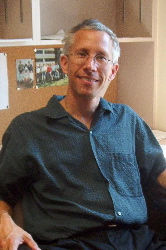
|
Ralf Brüning Ph.D. (1984−1990) Ralf studied reversible and irreversible relaxation processes in Pd40Ni40P20 metallic glasses. He used a combination of x-ray diffraction methods and 57Fe Mössbauer spectroscopy (made possible by doping the samples with about 1 at.% 57Fe). Ralf is now Associate Professor at Mount Allison University |
|
Hong Ren Ph.D. (1988−1993) Hong was my first graduate student, so he got the job of setting up my Mössbauer lab, pretty much from scratch. His research project centred on using 57Fe Mössbauer spectoscopy in an applied field to study transverse spin freezing in a-Fe100-xZrx and a-Fe90Sc10. He also worked on comparing dynamic vs. static modelling of the broad hyperfine field distributions observed in these complex and frustrated magnetic materials. |

|
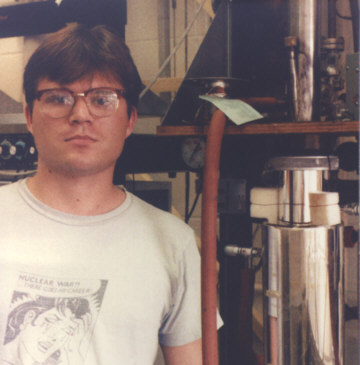
|
Andrew Dawson Ph.D. (1988−1994) Andrew joined me a few weeks after Hong Ren, and built a calorimeter that he used to investigate spin fluctuations in a-FexZr100-x around x=38 where the system changes from nearly- to weakly- magnetic with increasing x. His precision calorimetry data, acquired as a function of temperature and field, provided the clearest evidence to date for spin fluctuations in the specific heat. |
Previous group photographs...
This is a "work in progress", so if you are not here yet,
you will be soon.
Updated : 25-June-2023 by Dominic Ryan, ERP 425, (514) 398-6534